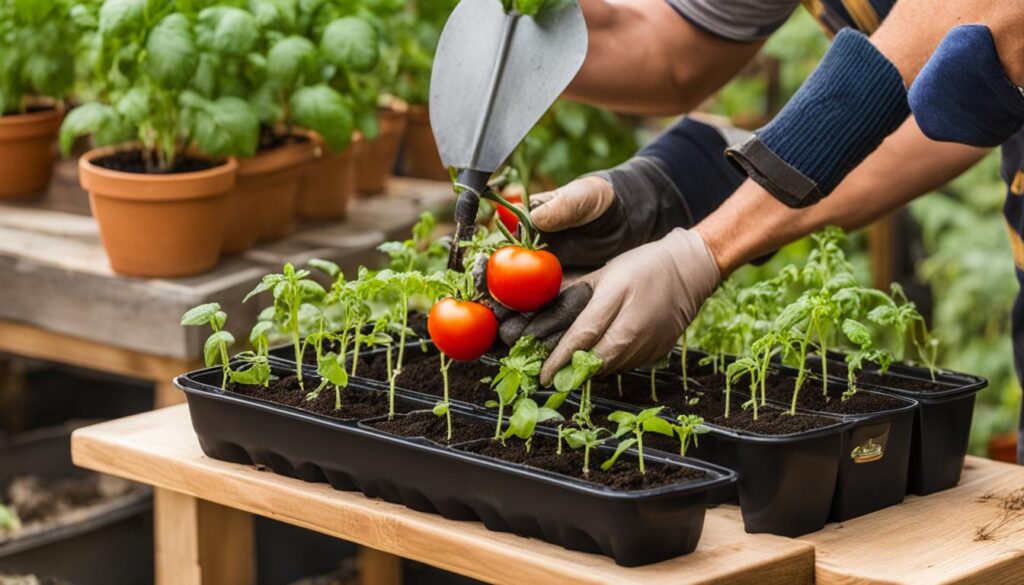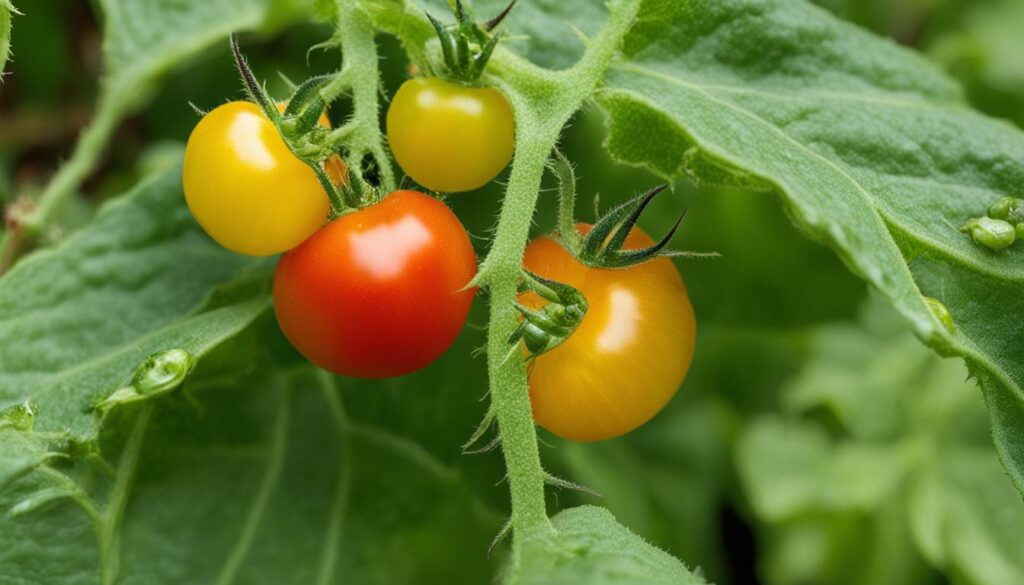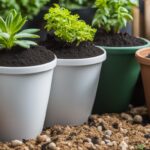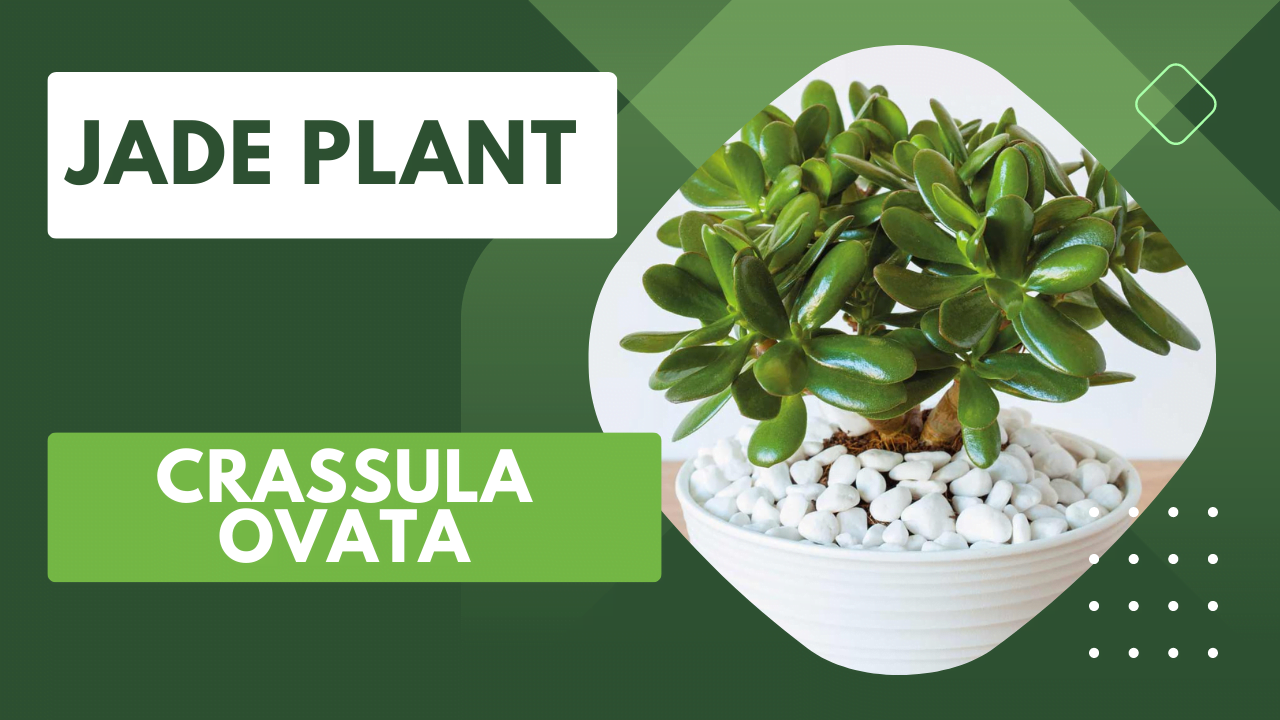Growing tomatoes in containers, pots, and grow bags are a fantastic way to enjoy homegrown tomatoes, even if you have limited space. Whether you have a small garden, a balcony, or a sunny windowsill, you can still have a bountiful tomato harvest. In this guide, I will share tips and techniques for successfully growing and carrying tips tomatoes in containers, pots, and grow bags, so you can enjoy the taste of fresh, juicy tomatoes all season long.

Key Takeaways:
- Container gardening allows you to grow tomatoes in small spaces and limited areas.
- Choose the right tomato varieties that are compact and suitable for container gardening.
- Provide proper support, watering, and feeding to ensure healthy tomato plants.
- Harvest tomatoes when they are fully ripened to enjoy their full flavor.
- Regular care and maintenance are essential for successful container tomato gardening.
Getting Started with Growing Tomatoes in Containers, Pots, and Grow Bags
If you’re eager to grow your own tomatoes but lack space in your garden, don’t worry! Growing tomatoes in containers, pots, and grow bags is a fantastic alternative that allows you to enjoy a bountiful harvest even with limited space. In this section, I’ll guide you through the essential steps to get started with container tomato gardening.
Choosing the Right Tomato Varieties
When it comes to selecting tomato varieties for container gardening, it’s essential to consider the size and growth habits that suit your available space. Compact and dwarf varieties are excellent choices as they require less room to grow. Look for varieties specifically bred for container cultivation, such as ‘Sungold’ cherry tomatoes, ‘Bush Early Girl’ determinate tomatoes, ‘Patio’ tomatoes, and ‘Tiny Tim’ cherry tomatoes. These compact options are perfect for pots, grow bags, or even hanging baskets.
Starting Tomatoes from Seeds
One of the joys of container tomato gardening is the ability to start your plants from seeds. This gives you a wide range of tomato varieties to choose from. Start by sowing the seeds indoors in late winter or early spring, 6-8 weeks before your last frost date. Use a good quality seed-starting mix and sow the seeds thinly on the surface. Cover lightly with compost and water gently. Place the seed trays in a warm location to encourage seed germination. Once the seedlings have developed their first true leaves, transplant them into individual pots filled with well-draining potting soil.
Planting Your Tomato Plants
Once your tomato seedlings have grown strong and sturdy, it’s time to plant them in their permanent containers. Choose pots or grow bags with sufficient drainage holes to prevent waterlogging. Fill the containers with a well-draining, nutrient-rich potting mix. Plant one tomato plant per 12-18 inch (30-45cm) pot or two plants in a larger grow bag. Place the containers in a sunny location where your plants can receive at least 6-8 hours of sunlight each day.
By following these steps, you’ll be well on your way to growing delicious, homegrown tomatoes in containers, pots, or grow bags. The satisfaction of harvesting your own tomatoes, no matter how limited your space may be, is incredibly rewarding.
You can also read about Grow Bottle Gourd (Lauki) From Seed
Sowing Tomato Seeds for Container Growing
When it comes to growing tomatoes in containers, starting from seeds is a cost-effective and rewarding option. Sowing tomato seeds indoors allows you to have control over the growing conditions and choose from a wide variety of tomato cultivars. Here are some essential tips to help you successfully sow tomato seeds for container gardening:
Choose the Right Tomato Seeds
Start by selecting tomato seeds that are well-suited for container growing. Look for compact or dwarf varieties that are specifically bred for small spaces. Consider factors such as growth habit, fruit size, and flavor to find the best tomato seeds for your container garden.
Timing is Key
Timing is crucial when it comes to sowing tomato seeds. Start sowing seeds indoors from late February to mid-March for greenhouse cultivation, or from late March to early April for outdoor growing. This ensures that the seedlings will be ready to be transplanted into containers once the risk of frost has passed.
You can also read about Grow and Care Curry Leaf Plant
Proper Seed Starting Technique
Use a good quality seed compost and sow the tomato seeds thinly on the surface. Cover the seeds with a thin layer of compost and water lightly. Maintain a temperature of around 18°C for optimal germination. Once the seedlings appear, transfer them to individual pots filled with multi-purpose compost, taking care not to damage the delicate stems.
| Benefits of Sowing Tomato Seeds for Container Growing | Tips for Successful Seed Starting |
|---|---|
|
|
Sowing tomato seeds for container growing is an excellent way to kickstart your tomato garden. By following these Tips for Successful Seed and providing the right care, you can enjoy a bountiful harvest of homegrown tomatoes in your containers.
Planting Tomatoes in Containers, Pots, and Grow Bags
In this section, I will guide you through the process of planting tomatoes in containers, pots, and grow bags. With the right techniques and proper care, you can successfully grow healthy and productive tomato plants in a limited space.
Choosing the Right Containers
When selecting containers for tomato cultivation, it is essential to choose options that provide sufficient depth and drainage. Plastic pots, ceramic containers, and fabric smart pots are all types of pot suitable choices. Ensure that the containers have drainage holes to prevent waterlogging, which can lead to root rot.
For container tomatoes, use loam-based or multi-purpose compost. This type of compost provides good drainage while retaining enough moisture for the plants to thrive. It is recommended to plant one tomato plant per 30-45cm pot, or two plants in a grow bag.
Planting Tips and Spacing
Young tomato plants grown from seeds indoors should be planted in containers or grow bags after the danger of frost has passed. Prior to planting, prepare the containers by filling them with the chosen compost. Plant the tomatoes deeply, up to the first set of leaves, as this encourages strong root development.
When spacing tomato plants in pots, allow 45-60cm of space between each plant, depending on the variety. Providing enough spacing ensures proper air circulation, reduces the risk of diseases, and allows the plants to receive adequate sunlight.

Care and Maintenance of Container Tomato Plants
When it comes to caring for tomato plants in containers, proper watering is essential for their health and productivity. Containers tend to dry out quickly, so it’s important to water them regularly and consistently. Aim to keep the soil or compost evenly moist, especially during hot weather. Daily watering may be necessary to prevent the plants from drying out.
Feeding your tomato plants in pots is equally important. Once the first fruits start to swell, it’s time to provide them with a high potassium liquid fertilizer. This will help promote healthy growth and optimize fruit production. Additionally, consider mulching the soil around the plants to retain moisture and suppress weed growth.
Pruning and training techniques vary depending on the type of tomato variety. For cordons, which are plants trained to grow as single stems, regular pruning and tying to supports are necessary to maintain their shape and remove unnecessary side shoots. Determinate varieties, on the other hand, do not require pruning.
Pruning and Training Tips:
- For cordons, remove the side shoots that form in the leaf axils to maintain a single stem.
- Use twine or soft ties to secure the main stem to vertical supports, such as canes or strings, or unused old moss poles (if you want).
- Regularly check for suckers that may develop in the leaf axils and remove them promptly.
- Consider using tomato cages or trellises for indeterminate varieties to support their sprawling growth habit.
| Pruning Techniques | Advantages | Disadvantages |
|---|---|---|
| Removing side shoots on cordons | Promotes better airflow and light penetration, resulting in healthier plants and larger fruits. | Requires regular maintenance and monitoring to prevent the development of new side shoots. |
| Using tomato cages or trellises for indeterminate varieties | Supports sprawling growth, prevents plants from collapsing, and makes harvesting easier. | May require additional space and initial setup. |
Harvesting and Storing Homegrown Tomatoes
When it comes to harvesting tomatoes from your container garden, timing is key. You want to pick the tomatoes when they have fully ripened and reached their optimal color. This timing may vary depending on the specific tomato variety and growing conditions. It’s best to avoid picking overripe fruits, as they tend to spoil quickly. To ensure a bountiful harvest, it’s important to harvest the tomatoes at the right time.
If the end of the season brings the threat of frost, you can take preemptive action to save your unripe tomatoes. Carefully lift the entire plant, including the green fruits, and hang it upside down in a sheltered location. This method allows the fruits to ripen gradually. It’s a great way to make sure you can enjoy your homegrown tomatoes even after the growing season has come to an end.
You can also read about How To Save Tulsi Plant From Dying
Green tomatoes can also be picked before the first frost and stored for later use. Simply place the unripe tomatoes in a cool place, such as a basement or garage, and let them ripen naturally. Check on them regularly to ensure they are ripening properly. Storing green tomatoes in this way allows you to extend the enjoyment of your homegrown produce throughout the year.
Tomato Harvesting and Storage Guidelines
| Step | Action |
|---|---|
| 1 | Harvest tomatoes when they have fully ripened and gained their full color. |
| 2 | Avoid overripe fruits as they spoil quickly. |
| 3 | If frost threatens, lift the entire plant, including green fruits, and hang it upside down in a sheltered location to allow the fruits to ripen. |
| 4 | For green tomatoes, pick them before the first frost and store them in a cool place to ripen gradually. |
| 5 | Check on stored green tomatoes regularly to ensure proper ripening. |
Common Problems and Pests in Container Tomato Gardening
While container gardening offers many advantages for growing tomatoes, it also presents its fair share of challenges. Common problems and pests can affect the health and productivity of your tomato plants. Understanding these issues and taking proactive measures can help you overcome them effectively.
Possible Tomato Plant Problems
To ensure the success of your container tomato garden, be aware of the following common problems:
- Tomato blight: This fungal disease can cause leaves and fruits to rot, ultimately leading to plant death. Regularly check your plants for signs of blight, such as brown spots on leaves, and promptly remove any affected foliage to prevent the spread.
- Blossom end rot: This condition causes the bottom of the tomato fruit to darken and rot. It is often caused by calcium deficiency or irregular watering. Maintain consistent moisture levels in the soil and provide adequate calcium through organic amendments or foliar sprays.
- Blossom drop: High temperatures, excessive humidity, and stress can cause tomato plants to drop their flowers. Ensure proper ventilation and temperature control in your growing environment to prevent blossom drop.
- Dry set: Dry set occurs when the flowers fail to form fruits. It can be caused by extreme temperatures, poor pollination, or nutrient imbalances. Maintain optimal growing conditions and consider hand-pollinating the flowers to improve the fruit set.
- Splitting fruits: Tomatoes may split or crack due to rapid fluctuations in moisture levels. To prevent this issue, maintain consistent soil moisture by watering regularly and mulching around the plants to conserve moisture.
Common Tomato Plant Pests
Here are some pests that commonly affect tomato plants:
- Aphids: These small insects feed on the sap of tomato plants, causing stunted growth and distorted foliage. Regularly inspect your plants for aphids and use organic insecticidal soaps or natural predators to control their population.
- Whiteflies: These tiny white insects suck sap from the leaves, causing yellowing, wilting, and reduced plant vigor. Install yellow sticky traps to monitor and catch whiteflies, and use insecticidal soap or biological controls to manage their numbers.
- Tomato hornworms: These large green caterpillars can quickly defoliate tomato plants. Handpick hornworms and destroy them, or use organic insecticides like Bacillus thuringiensis (Bt) to control their population.

Preventing Diseases in Tomatoes
To prevent diseases in your tomato plants, practice the following preventive measures:
- Start with disease-resistant tomato varieties: Choose tomato varieties that are resistant to common diseases, such as blight and fusarium wilt.
- Ensure proper air circulation: Good air circulation helps reduce humidity and prevents the development and spread of fungal diseases. Space your tomato plants adequately and avoid overcrowding.
- Water at the base: Watering the base of the plants instead of overhead reduces moisture on the foliage and minimizes the risk of fungal diseases. Use drip irrigation or a watering can to apply water directly to the soil.
- Rotate your crops: Avoid planting tomatoes in the same container or location year after year. Rotate your crops to minimize the buildup of disease pathogens in the soil.
- Maintain clean gardening practices: Remove and dispose of any diseased plant material promptly. Clean your gardening tools regularly to prevent the spread of pathogens.
By being aware of common problems and pests, and implementing preventive measures, you can enjoy a thriving and productive container tomato garden.
Choosing the Right Containers and Grow Bags for Tomato Cultivation
When it comes to growing tomatoes in containers, choosing the right containers and grow bags is crucial for the success of your plants. The containers you select should have sufficient depth and drainage holes to ensure proper root development and prevent waterlogging. Plastic pots, ceramic containers, and fabric smart pots are all suitable options for growing tomatoes.
Grow bags provide a space-saving solution and can accommodate multiple tomato plants. When choosing grow bags, look for ones with handles for easy movement. Fabric grow bags are particularly convenient, as they are durable and allow for proper aeration of the plant’s roots. Plus, they can be folded and stored when not in use.
Container Gardening Tips:
- Choose containers with sufficient depth and drainage holes.
- Consider different materials like plastic, ceramic, or fabric.
- Opt for grow bags with handles for easy movement.
- Ensure the container size matches the plant’s growth habit and space requirements.
- Think about the durability and aesthetics of the containers.
By selecting the right containers and grow bags, you can create an optimal environment for your tomato plants to thrive. Remember to provide adequate water, sunlight, and nutrients, and your plants will reward you with bountiful and delicious tomatoes throughout the growing season.
| Container Type | Pros | Cons |
|---|---|---|
| Plastic Pots | – Lightweight and easy to move. – Available in various sizes and colors. | – Can become brittle and crack over time. – May require additional insulation in extreme temperatures. |
| Ceramic Containers | – Durable and aesthetically pleasing. – Provide good insulation for the roots. | – Can be heavy and difficult to move. – May require extra drainage holes. |
| Fabric Smart Pots | – Allows for excellent drainage and aeration. – Can be folded and stored when not in use. | – Requires more frequent watering compared to traditional pots. |
| Grow Bags | – Space-saving option for growing multiple plants. – Provides ample room for root development. | – Requires additional support for tall and heavy plants. – Limited aesthetic appeal. |
Tips for Growing Tomatoes in Limited Space and Small Gardens
Are you eager to grow tomatoes but limited by space or a small garden? Don’t worry, you can still enjoy a bountiful harvest with these tips for growing tomatoes in small spaces. Whether you have a tiny backyard, a balcony, or even just a window sill, there are creative techniques to maximize your tomato yield.
Vertical Tomato Gardening
One effective way to grow tomatoes in limited space is through vertical gardening. This method involves training tomato plants to grow upward along trellises, cages, or strings. By utilizing vertical space, you can save valuable ground space and promote efficient growth. Proper support and regular pruning are essential to maintain compact growth and prevent plants from sprawling.
Hanging Basket Tomato Plants
Another option for small gardens or balconies is to grow tomatoes in hanging baskets. Trailing or cascading tomato varieties are well-suited for this method. Choose compact or dwarf varieties that thrive in containers. Hanging baskets not only save space but also add a decorative touch to your garden. Just make sure to provide adequate support and regular care for your hanging tomato plants.
With these innovative techniques, you can successfully grow tomatoes in limited spaces and small gardens, bringing the joy of homegrown tomatoes to even the tiniest of spaces.
| Advantages | Disadvantages |
|---|---|
| Maximizes limited space | Requires regular pruning and support |
| Efficient use of vertical space | May require additional watering due to increased exposure to sunlight and wind |
| Decorative and visually appealing | Can be challenging to find suitable containers and supports |
Best Tomato Varieties for Container Gardening
If you’re looking to grow tomatoes in containers, there are several varieties that are particularly well-suited for this type of gardening. Compact and dwarf varieties are excellent options as they require less space but still deliver abundant yields. Here are some recommended tomato varieties for container gardening:
- ‘Sungold’ cherry tomatoes: These small, sweet tomatoes are a popular choice for containers. They have a vibrant orange color and a deliciously fruity flavor.
- ‘Bush Early Girl’ determinate tomatoes: This variety is known for its early maturity, making it a great option if you want to enjoy ripe tomatoes sooner. The plants are compact and produce medium-sized fruits.
- ‘Patio’ tomatoes: As the name suggests, these tomatoes are specifically bred for container gardening. They have a compact growth habit and produce juicy, flavorful tomatoes.
- ‘Tiny Tim’ cherry tomatoes: These miniature-sized tomatoes are perfect for small spaces. Despite their tiny size, they pack a punch in terms of flavor and are great for snacking or adding to salads.
These tomato varieties are not only well-suited for containers but also offer a range of flavors and colors to suit your preferences. Whether you’re growing them in pots, grow bags, or hanging baskets, these varieties will thrive and provide you with a bountiful harvest.
Recommended Tomato Varieties for Containers
| Tomato Variety | Growth Habit | Flavor | Fruit Size |
|---|---|---|---|
| ‘Sungold’ cherry tomatoes | Indeterminate | Sweet and fruity | Small |
| ‘Bush Early Girl’ determinate tomatoes | Determinate | Classic tomato flavor | Medium |
| ‘Patio’ tomatoes | Determinate | Juicy and flavorful | Medium to large |
| ‘Tiny Tim’ cherry tomatoes | Indeterminate | Intense and sweet | Small |
When choosing tomato varieties for container gardening, consider factors such as growth habit, flavor, and fruit size. Compact and dwarf varieties are ideal for small spaces, while cherry tomatoes are great for snacking and adding to dishes. With the right tomato varieties, you can enjoy a successful and rewarding container tomato garden.
Tips for Successful Container Tomato Gardening
When it comes to container tomato gardening, there are a few key tips that can help you maximize your yields and have a successful harvest. First and foremost, choosing the right tomato varieties for your containers is essential. Look for compact or dwarf varieties that are well-suited for container gardening. This way, you can make the most of your limited space without compromising on flavor or yield.
Another important aspect of container tomato gardening is providing proper support for vertical growth. Tomatoes naturally want to climb, so using trellises, cages, or strings can help them grow upward and save valuable space. Just make sure you secure the supports firmly and tie the plants as they grow to ensure they stay upright.
The quality of your soil or compost is crucial for the success of your container tomatoes. Make sure you use a well-draining and nutrient-rich mixture that provides the right balance for healthy growth. Regular watering is also key, as containers can dry out quickly, especially in hot weather. Aim for consistent and even moisture to keep your plants hydrated and happy.
Lastly, don’t forget to feed your container tomato plants with appropriate fertilizers during the growing season. Tomatoes are heavy feeders, so providing them with the nutrients they need will help ensure robust growth and abundant yields. Keep an eye out for any pests or diseases and take prompt action to prevent or treat any issues that may arise.
By following these container gardening tips for tomatoes, you can create a thriving garden even in limited space. With the right tomato varieties, proper support, good soil, regular watering, and feeding, you’ll be well on your way to maximizing your tomato yields and enjoying delicious homegrown tomatoes throughout the growing season.
FAQ
How do I start growing tomatoes in containers, pots, or grow bags?
To start growing tomatoes in containers, pots, or grow bags, choose the right tomato variety suitable for your space. You can start tomatoes from seeds indoors or buy young plants. Provide a warm and sunny site for optimal growth.
When should I sow tomato seeds for container growing?
Sow tomato seeds indoors from late February to mid-March for greenhouse cultivation, or from late March to early April for outdoor growing. Use good quality seed compost and maintain a temperature of around 18°C for germination.
How do I plant tomatoes in containers, pots, or grow bags?
Plant young tomato plants in containers or grow bags in early summer, after the danger of frost has passed. Use well-draining and nutrient-rich soil or compost. Space the plants according to the variety and provide proper support for vertical growth.
How often should I water tomato plants in containers?
Water container tomato plants regularly to keep the soil or compost evenly moist. Containers tend to dry out quickly, so daily watering may be necessary, especially in hot weather.
How do I harvest and store homegrown tomatoes?
Harvest tomatoes when they are fully ripened and have gained their full color. Avoid overripe fruits. If frost threatens, lift the plants with unripe fruits and hang them upside down in a sheltered location for ripening. Green tomatoes can be picked and stored in a cool place to ripen gradually.
What are common problems and pests in container tomato gardening?
Common problems include tomato blight, blossom end rot, blossom drop, dry set, and splitting fruits. Common pests include aphids, whiteflies, and tomato hornworms. Regular monitoring and appropriate care can prevent many of these issues.
What are the best containers and grow bags for tomato cultivation?
Choose containers with sufficient depth and drainage holes, such as plastic pots, ceramic containers, or fabric smart pots. Grow bags are space-saving options. Consider the material, durability, and aesthetics when choosing containers.
How can I grow tomatoes in limited space and small gardens?
Utilize vertical gardening techniques by training tomatoes to grow upward along trellises, cages, or strings. Hanging baskets are also suitable for trailing or cascading tomato varieties. Choose compact or dwarf varieties and optimize vertical space.
What are the best tomato varieties for container gardening?
Recommended varieties for container gardening include ‘Sungold’ cherry tomatoes, ‘Bush Early Girl’ determinate tomatoes, ‘Patio’ tomatoes, and ‘Tiny Tim’ cherry tomatoes. Choose varieties based on flavor, color, and size preferences.
What are some tips for successful container tomato gardening?
Choose suitable tomato varieties, provide proper support for vertical growth, use well-draining soil or compost, water regularly, feed with appropriate fertilizers, monitor for pests and diseases, and practice proper pruning, training, and harvesting techniques.




